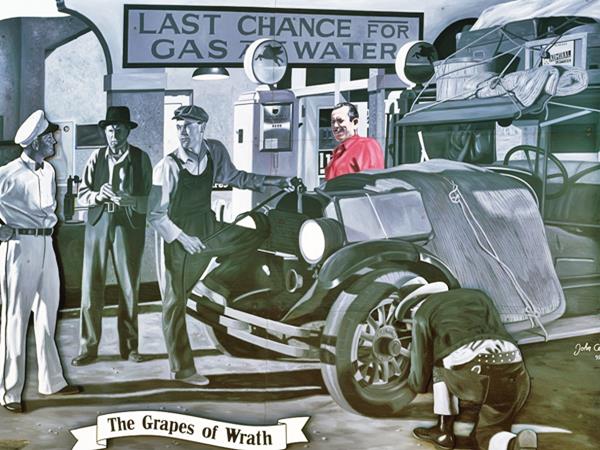US 66 Facts
John Steinbeck
The Author
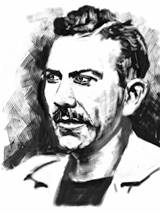
John Steinbeck. Kiran Guckian
John Steinbeck (1902 -1968).
Steinbeck was an American novelist, war correspondent and short story writer who was awarded the Nobel Prize in Literature in 1962.
Born in Salinas, California (Feb. 27, 1902), he absorbed his local and regional setting and people, which he would masterfully render in his later works set in Southern California.
Among his most known works are Tortilla Flat (1935), Of Mice and Men (1937), The Grapes of Wrath (1939), Cannery Row (1945), and East of Eden (1952).
His left of center political views surfaced in his writing, which often depicted the plight of the poor, the exploited common man, who are portrayed as toys of fate and injustice.
The Grapes of Wrath received the 1940 Pulitzer Prize for fiction and has sold over 14 million copies during the first 75 years since it was published.
Steinbeck died in New York, USA, on Dec. 20, 1968 at the young age of sixty six.
The Novel: The Grapes of Wrath
Summary of the Plot
The Grapes of Wrath is set in the mid-1930s, in the United States. The Great Depression and the Dust Bowl drought in the Midwest have disrupted the American economy and millions of laborers and farmers are unemployed.
The novel describes the fate of a family of sharecroppers, the Joads. They lose their land and home, pack their scant belongings and head west, to California seeking a new start.
The Title, meaning
Definition of Wrath: "1. An intense emotional state of displeasure with someone or something, 2. Suffering, loss, or hardship imposed in response to a crime or offense."
The phrase is taken from a stanza of the "The Battle Hymn of the Republic." This song was written in 1861 by Julia Ward Howe. It soon became popular and was adopted as an anthem by the abolitionist cause and the Unionist soldiers during the American Civil War.
You may not recognize the song by its title, but its lyrics will sound familiar:
Mine eyes have seen the glory of the coming of the Lord:
He is trampling out the vintage where the grapes of wrath are stored;
He hath loosed the fateful lightning of His terrible swift sword:
His truth is marching on.(Chorus)
Glory, glory, hallelujah!
Glory, glory, hallelujah!
Glory, glory, hallelujah!
His truth is marching on. Julia Ward Howe (1861)
The inspiration for the hymn's title came from the Bible's Book of Revelation (14:19-20): "So the angel swung his sickle to the earth and gathered the clusters from the vine of the earth, and threw them into the great wine press of the wrath of God."
In the case of the hymn, the words refer to the vengeance of God against the evil ways of mankind (i.e. slavery in the Confederate states).
Steinbeck's first wife Carol suggested the title to him, and he followed her advice. In the novel, the "grapes of wrath" takes the meaning to a less bellicose level: capitalist oppression; the greed of banks and landowners who exploit the poor, dispossess the farmers, and cause suffering to hundreds of thousands of migrant workers.
Publication
The novel was published on April 14, 1939 by Viking Press-James Lloyd.
It won the National Book Award and the Pulitzer Prize for fiction, and was one of the reasons for granting Steinbeck the Nobel Prize for Literature in 1962.
Context
The Dust Bowl

Heavy black clouds of dust rising over the Texas Panhandle, March 1936
Arthur Rothstein
A severe drought in the 1930s struck the Midwest. Poor farming techniques led to wind erosion, and the dry topsoil without vegetation to hold it town, was blown away. This caused to vast dust storms in the prairies of the U.S. and also in Canada.
Ominous dust clouds darkened the sky and they were known as "black blizzards". The wind deposited dust as far east as New York. Over 100 million acres (400,000 km2 of once verdant farmland was affected by erosion and drought.
Tens of thousands of farmers with their families had to abandon their farms as they defaulted their mortgages. They moved on to seek fortune elsewhere.
An estimated 210,000 people took to the road and migrated to a promised land in California seeking jobs. But the Great Depression had struck the nation and most of them drove back; only 8% of them remained in the Golden State.
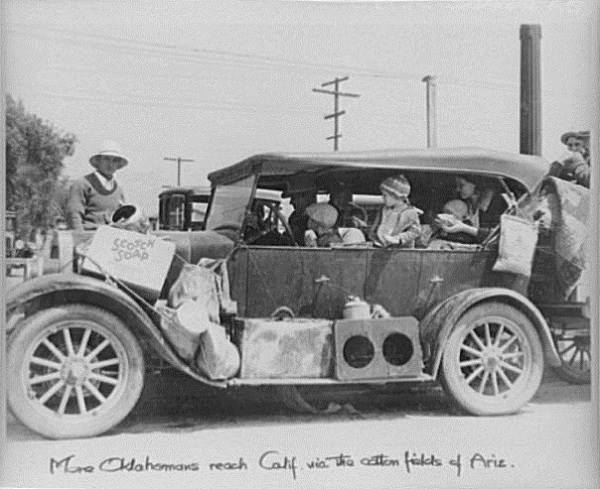
The Great Depression
Following the stock market crash in the US on October 24, 1929, billions of dollars were lost, having been invested in a speculative bubble. Banks cut credit while their customers ran on the banks to withdraw their savings causing banks to fail and close. People lost their savings. A severe recession set in, jobs were lost and by 1933 unemployment stood at 25%. Income fell and sales plummeted. Foreclosures led to loss of homes, farms and businesses. It spread globally due to restrictions in credit, protectionist tariffs that blocked imports and lower demand. Active government intervention provided work and income to millions during the FDR presidencies starting in 1933. It was only the increased government spending caused by WWII that ended the Depression in the US.
The Story
Tom Joad is paroled from prison (he was serving a term for homicide). He returns to his home on a farm in Oklahoma in the company of a roaming preacher (Jim Casy).
They find the farm deserted and learn that the family has moved over to Uncle John Joad's place because the Joads and other farmer have been evicted by the banks. But, Uncle John refuses to budge.

The Dust Bowl caused crops to fail and the lack of cash led farmers to default on their loans, their farms were repossessed and with nothing left, the Joads must move on.
The Joads pack their scant belongings into the family's car reconverted to a truck and start a journey to California where, apparently there are jobs available. Tom and Casy join them in their exile.
The road they take is no other than Route 66 which Steinbeck names the "Mother Road": "66 is the mother road... the road of flight." As they travel, they meet other migrants, and many returning without having found jobs.
Granpa dies on the way and so does Granma. The group splits up when the eldest son Noah and the husband of the pregnant Joad daughter (Rose of Sharon) depart. Ma Joad leads them onwards, as there is nothing to go back to.
Once in California the prospects are grim, jobs are scarce and wages low and migrants are exploited by the large farming concerns. The exiles find refuge in Weedpatch Camp, run by the Federal Resettlement Administration, which offers some protection to the needy.
Weedpatch Camp was inspired by the Arvin Federal Government Camp near Bakersfield. It exists to this day
Casy tries to organize a labor union to resist exploitation. A strike in a peach orchard turns sour and Casy is beaten to death, but Tom Joad kills the attacker and escapes. The family moves to a cotton farm where Tom moves on and Rose of Sharon's child is stillborn. Ma Joad stands strong, and as they seek shelter from a flood, they find a young boy with his father, who is dying from starvation, and Rose of Sharon saves him by offering him her breast.
Grapes of Wrath Trivia
American folk music singer, composer and songwriter, Woody Guthrie (1912-1967) wrote "The Ballad of Tom Joad" in his 1940 album Dust Bowl Ballads.
Rock singer and author Bruce Springsteen's album "The Ghost of Tom Joad" (1995) contains the song "The Ghost of Tom Joad," that draws a parallelism between the Dust Bowl era and our times.
The book was controversial in its time; it was banned in the U.S.S.R. by Stalin because it showed that even the poorest Americans could own a car.
It was burned in many places across America, and declared to be "communist propaganda". Steinbeck received death threats.
When he finished the book, Steinbeck wrote: "It isn't the great book I had hoped it would be. It's just a run-of-the-mill book." He was off mark because, eventually, it earned him the Nobel Prize for Literature.
Darryl Zanuck bought the film rights for The Grapes of Wrath for $75,000.
Henry Fonda, who played the part of Tom Joad, became a good friend of Steinbeck.
The Movie by John Ford
The Grapes of Wrath
128 minutes, Black and White. (Released: Jan 24, 1940).
Director John Ford
Screenplay Nunnally Johnson based on the novel by John Steinbeck.
Produced by: Nunnally Johnson and Darryl F. Zanuck.
Photography: Gregg Toland.
Prizes: Academy Award for Best Director (John Ford) and Best Actress in a Supporting Role (Jane Darwell).
Leading Cast:Henry Fonda, Jane Darwell, John Carradine.
This is one of the few movies that dealt with the terrible suffering caused by the Great Depression and the Dust Bowl drought of the 1930s and was contemporary with those events. It portrays the bleak reality, the turmoil, loss and pain of sharecroppers, who had lost their land in Oklahoma and had to relocate in California seeking the opportunity to survive.
Review: "Loss and Hope
Reviewed by Austin Whittall.
Written on March 30, 2015
This movie is a strong and harsh portrayal of the suffering of the Joads, which was not due to their extreme poverty but to the terrible loss provoked by their uprooting, the loss of their home, their farm, their roots and sense of belonging.
Toland's photography is excellent; it captures reality with the clearness of a documentary and emulates the photography of Dorothea Lange, who was commissioned by the U.S. government to record the unfortunate situation of the Oklahoma farmers.
The story, based on Steinbeck's novel deals with a family of Oklahoma farmers, dispossessed of their home and land, who embark on a trip to find a new start in California, seeking survival like thousands of others.
In the film, the crude portrayal of the novel is softened: the fate of the migrant farmers takes a turn for the better, and offers a glimmer of hope in the closing lines of Ma Joad (played by Jane Darwell, who won an Academy Award for her role): "Rich fellas come up an' they die, an' their kids ain't no good an' they die out. But we keep a'comin'. We're the people that live. They can't wipe us out; they can't lick us. We'll go on forever, Pa, 'cause we're the people."
Route 66 and the Movie
John Ford, who directed "The Grapes of Wrath" knew Route 66. He had just finished shooting the classic western movie "Stagecoach" starring John Wayne (1939) in Monument Valley, Arizona - Utah, and had to drive down US 66 to get there.
Let's look at some of the locations of "The Grapes of Wrath" along Route 66 shown in the movie. These are views taken by Ford in 1940. From east to west, they are the following.
Kansas
Two of the characters in The Grapes of Wrath were from Galena, Kansas: Sairy and Ivy Wilson.
Oklahoma
Sayre
At the beginning of the movie, there is a scene that used Sayre Oklahoma's Beckham County Courthouse as a backdrop, it is shown below, a mix of poverty, despair, hope and the stern County building looking down on the forced migrants. The color picture is the current view at the same spot. Click on it for the street view.
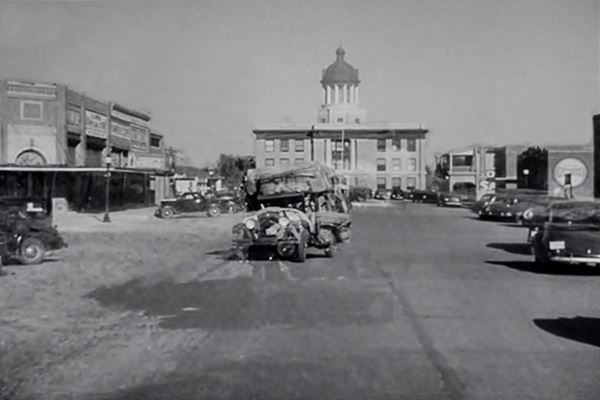
New Mexico
Santa Rosa
There is a scene in the 1940 movie where Henry Fonda (interpreting Tom Joad) watches a train crossing the Pecos River Bridge, shot in Santa Rosa, and another with the truck of the Joads crossing the Pecos River on the western side of that city. Both are shown below (stills from the movie).

Pecos River Railroad Bridge. large size image
Street View
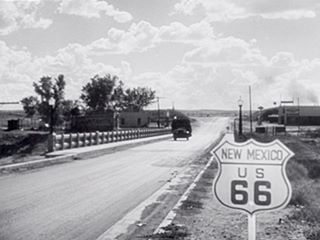
Pecos River US 66 Bridge.
Street View
The truck scene is looking west but the Joads were heading from Oklahoma to California and should have been heading west not east. The scene must have been shot in the opposite direction to take advantage of the light.
Arizona
Lupton
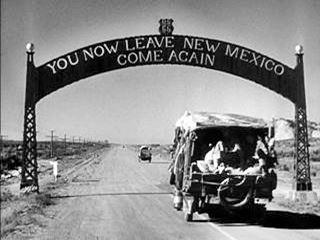
The Gateway Arch at New Mexico - Arizona state line on Route 66. From The Grapes of Wrath (1940)
Another scene was shot at the state line between NM and AZ in Lupton Arizona. The truck can be seen passing through the archway on the border, entering Arizona.
These people were not wanted in Arizona, and the state officials made it clear to them, they had to keep on moving and reach California. Arizona would not be a haven for them. Steinbeck describes the terse exchange when the "Border Guard" stopped them, as follows:
"Where you going?"
"To California," said Tom.
"How long you plan to be in Arizona?"
"No longer'n we can get across her."
"Got any plants?"
"No plants."
"I ought to look your stuff over."
"I tell you we ain't got no plants."
The guard put a little sticker on the winshield.
"O.K. Go ahead, but you better keep movin'."
"Sure. We aim to." John Steinbeck - The Grapes of Wrath
Joad is clear, he is going to California, Arizona is of no interest, he may be poor and homeless, but he is still a proud man with a mission.
For the Route 66 historian, the images from John Ford's movie are interesting, they were clearly shot in Lupton, the Painted Cliffs are the badckdrop to the "State Inspection Station" (see image below).
Looking east from the Border Control Station near Lupton's Painted Cliffs. Route 66 as it was in 1940.

The same spot nowadays, is pictured below; it is on the South Frontage Road, looking east.
Border control station site nowadays
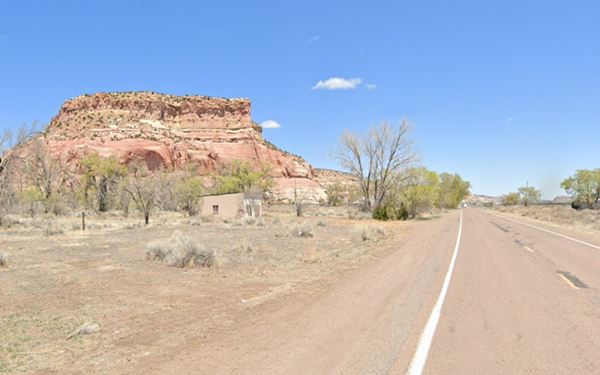
Topock AZ

The Joads reached the Colorado River on the western tip of Route 66 in Arizona, in Topock AZ. There is a long a scene see the video below showing the Joads as they reach Topock and park by the Colorado River bridge, and then cross it. The still further up shows part of this scene and in it you can see the stone "The Needles" beyond the curve in the Colorado River:
Video of Grapes of Wrath (1940)
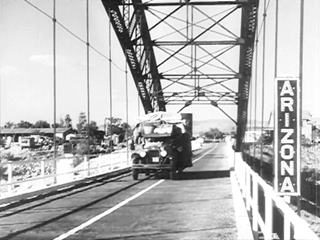
Dust Bowl and the Great Depression, "Grapes of Wrath", US66 and the Colorado River Bridge
The black and white image is a still from the movie showing the Joads crossing the Colorado River along the steel arch bridge in 1940. Below is a current view of the jagged Needles mountains.
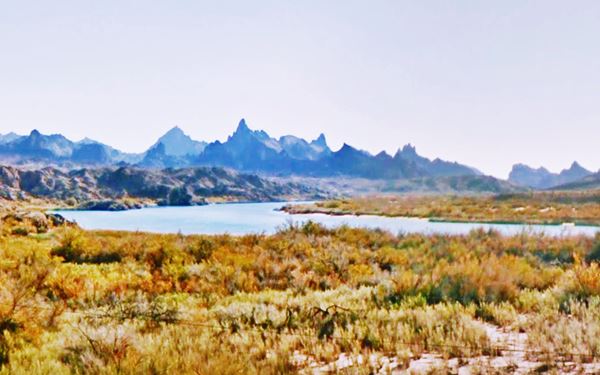
Trails Arch Bridge
Listed in the National Register of Historic Places in 1988.
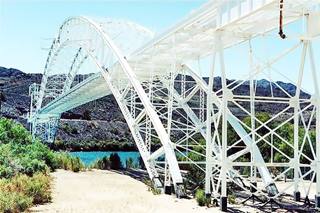
The Topock Bridge, Arizona & California. Credits
The cars that drove along the roads of the 1910s, crossed the Colorado River using the Needles Ferry. But a flood razed the ferry in 1914 so the cars crossed the river using the railroad's Red Rock Bridge: planks were laid across the tracks and the cars crossed between trains.
There was a bridge on the "Ocean-to-Ocean" route at Yuma, but the Los Angeles to St. Louis National Old Trails Highway also required a bridge across the Colorado River
In 1914, the states of Arizona and California, the US Bureau of Indian Affairs and San Bernardino County agreed to build a bridge.
The structure is a steel arch bridge with a "cantilever system" where the arch was assembled in two halves on each side of the river and then hoisted into place and linked together with a ball-and-socket central hinge.
At 800 ft. (243 m) in length and with a span of 600 ft. (182 m), it was the longest arch bridge in America until 1928.
The bridge was completed on Feb. 20, 1916 and carried the traffic of the N.O.T. highway. In 1926, U.S. 66 was aligned across it and remained so until 1947 when it was replaced by the Red Rock Bridge which the AT&SF railroad had just stopped using.
Its deck was removed in 1948 and a natural gas pipeline was laid across it; it is still in use.
California
Needles

Still from The Grapes of Wrath, 1940 at Carty's Camp. Source. Click to enlarge
The video further up, shows the Joads playing in the Colorado River on the Californian shore, in Needles CA.
The Joads drove to Needles, and the image is a still in the movie showing "Carty's Camp", a tourist campground with cabins and campground tourist cabins and a filling station.
Below is another still from the video, on the eastern side of Needles, with the "Needles Welcomes you to California" billboard.

Carty’s Camp as it stands nowadays
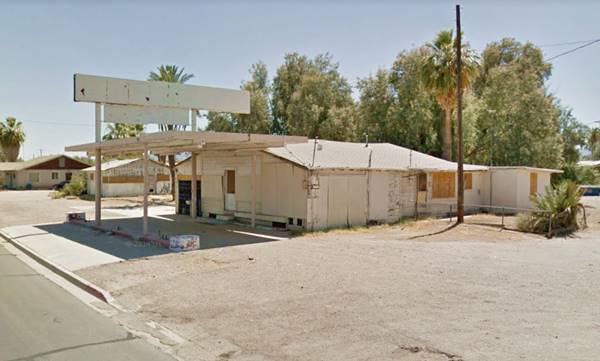
There was a grade crossing here where two spurs crossed the highway until the 1960s. You can see the warning signs in both movie stills.
Daggett
The family crosses the Mojave Desert at night, reaching the California Agricultural Inspection Station in Daggett. The station was established to prevent the introduction of diseased fruits and plants into California, to protect its crops and citrus groves.
Cars were stopped and checked here and at other stations along California's borders. Travelers were given an admission certificate to continue their journey, but during the Dust Bowl and Great Depression, it also served as a "border control", turning back many of those seeking jobs in California.


The Daggett Inspection Station. From The Grapes of Wrath (1940) Source.
Click to enlarge
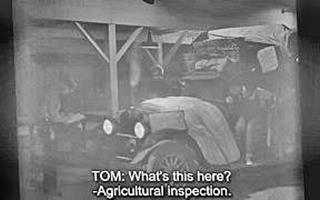
Daggett Inspection Station US66. From The Grapes of Wrath (1940)
One of the key scenes of the Joad's journey was shot in Daggett. They were in bad shape, when they reached Daggett they were stopped, the following is an excerpt from the book with the strained exchange at the Inspection Station:
It was near midnight when they neared Daggett, where the inspection station is. The road was flood-lighted there, and a sign illuminated, "KEEP RIGHT AND STOP." The officers loafed in the office, but they came out and stood under thelong covered shed when Tom pulled in. One officer put down the license number and raised the hood.
Tom asked, "What's this here?"
"Agricultural inspection. We got to look over your stuff. Got any vegetables or seeds?"
"No," said Tom.
"Well, we got to look over your stuff. You got to unload."
Now Ma climbed heavily down from the truck. Her face was swollen and her eyes were hard. "Look, mister. We got a sick ol' lady. We got to get her to a doctor. We can't wait." She seemed to fight with hysteria. "You can't make us wait."
"Yeah? Well, we got to look you over."
"I swear we ain't got anything!" Ma cried. "I swear it. An' Granma's awful sick."
"You don't look so good yourself," the officer said.
Ma pulled herself up the back of the truck, hoisted herself with huge strength. "Look," she said.
The officer shot a flashlight beam up on the old shrunken face. "By God, she is," he said. "You swear you got no seeds or fruits or vegetables, no corn, no oranges?"
"No, no. I swear it!"
"Then go ahead. You can get a doctor in Barstow. That's only eight miles. Go on ahead."
Tom climbed in and drove on. John Steinbeck - The Grapes of Wrath
Some sponsored content:
>> Book your Hotel in Santa Monica

Credits
Banner image: Hackberry General Store, Hackberry, Arizona by Perla Eichenblat.


